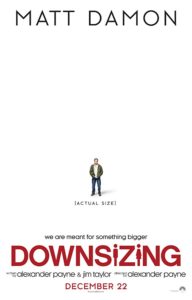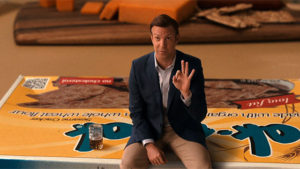In the social satire, Downsizing, an everyman (Matt Damon) shrinks himself down to five inches in height so he can live a life of wealth and splendor, but instead discovers the true value in human relationships.
Although this film was more visual effects heavy than the usual Alexander Payne film–and a lot of thought went into the VFX, such as hiring an urban planner to determine how the city was designed– editor Kevin Tent felt the editing was similar to his other collaborations with the director. “We really let the performances drive our choices in what we thought were believable and keeping the story going,” stated Tent. “The next layer added on top would be working with the visual effects.”
 Tent felt Damon did a phenomenal job, giving great choices in multiple takes, so that the filmmakers could adjust how fast or subtle or funny, they wanted to be with the performance, in order to give the story more depth. Damon would “always show up,” every take was good. He was always in character.
Tent felt Damon did a phenomenal job, giving great choices in multiple takes, so that the filmmakers could adjust how fast or subtle or funny, they wanted to be with the performance, in order to give the story more depth. Damon would “always show up,” every take was good. He was always in character.
Performances by Christoph Walz and Hong Chau were also amazing and blew Tent away. “This is Chau’s first real big movie. I think she totally nailed it. She steals the show,” commented Tent. “As an editor, sometimes you have these great moments and this was one of them. Her dailies came in and I was one of the first people to see her. That take where she’s giving the speech where she is going to Norway, that was take one! An that’s the take that’s in the movie.”
Turning the script into a movie was the biggest challenge that Tent faced in the editing. The story was really big, “almost like an novel.” The first cut, which followed the script, was over two hours long. Payne shot a lot of footage, and paring it down wasn’t just about pacing, but also about making connections and keeping all the story lines moving. The editor worked closely with Payne, constantly adjusting the edit, taking things out, putting them back in, with about 45 minutes ending up on the cutting room floor.
 Most of the cut footage came out in big sections, mostly from the beginning and the end that related to setting up the world and the relationship between Damon and his onscreen wife played by Kristen Wiig. The filmmakers had to focus it down to the main character played by Damon and what was happening to him in the story and his world.
Most of the cut footage came out in big sections, mostly from the beginning and the end that related to setting up the world and the relationship between Damon and his onscreen wife played by Kristen Wiig. The filmmakers had to focus it down to the main character played by Damon and what was happening to him in the story and his world.
About losing good material from the screenplay, Tent emphasized that the audience really wants to know, “Who am I supposed to watch and what’s going on with them.”






